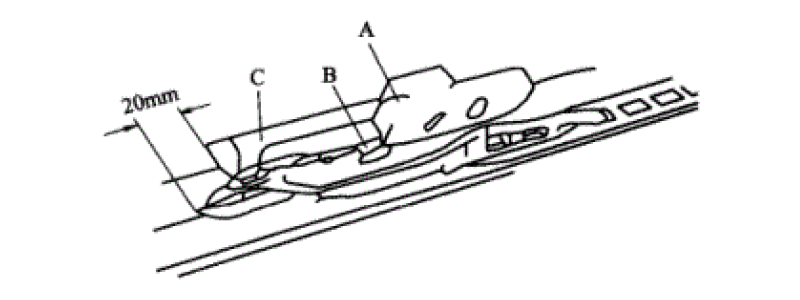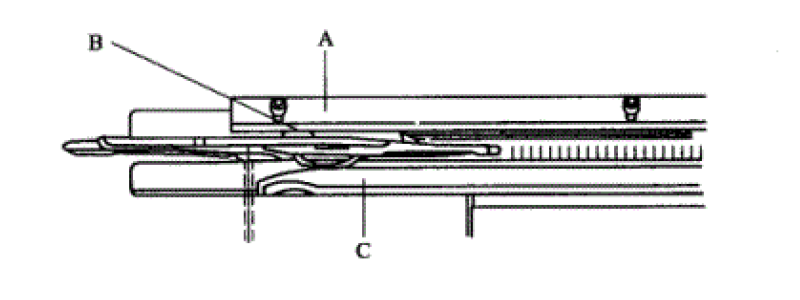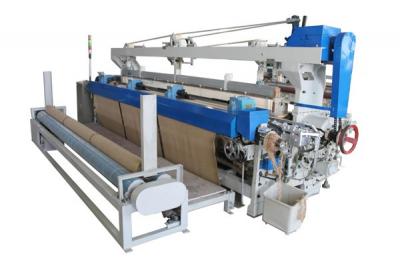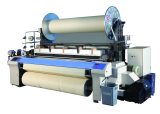Four Things You Should Know About Rapier Gripper Head
The rapier loom completes weft insertion through the rapier gripper head and rapier tape. The rapier head and rapier tape are the core components of the rapier loom. Here are the four things you should know about gripper head.
1. The Function and Standard of the Gripper Head
1) The function of the gripper head
The gripper head is the primary device for completing the weft insertion motion in the rapier loom. It is composed of the weft sending gripper and the receiving gripper, respectively mounted at the tops of the two rapier tapes, taking reciprocating movement on the guide rail.
The sending gripper grips the weft yarn sent by the weft selection finger from the left side of the loom, carries it into the center of the shed. The receiving gripper reaches the center of the loom and carries the weft to the right side of the shed. Meanwhile, the sending gripper also retracts to the left of the shed. Thus, the sending gripper and receiving gripper complete the first cycle of weft insertion, and the reed starts beating-up.
2) The standard that the gripper head should have for weaving
① The appearance of the gripper head.
a. The surface of the rapier gripper head should be smooth, without waste edges, burrs, cracks, depressions, or bubbles, to avoid weft breakage.
b. The warp yarn contact surface should be smooth, without any defects that may cause warp breakage.
② The performance of sending gripper should be stable and reliable. The contact surface between weft yarn presser and left housing should be flat. And the height of the weft presser head should ensure that all kinds of weft yarns can enter the jaws and be gripped firmly, without causing weft breakage or weft slough.
③ The working surface of the weft clamp lever on receiving gripper and the grip hook should be smooth, free of burrs, firmly snapped, and flexible to open, to guarantee reliable weft clamping.
④ The gap between the yarn guide on receiving gripper and the grip hook metalhead should be determined according to the thickness of the weft, generally controlled at 0.3-1.2mm, to ensure that all threads can enter smoothly.
⑤ In principle, the weight of the rapier gripper head is determined during the initial designing of rapier looms. The weight of several commonly used rapier gripper heads is shown below for reference.

2. Types of Gripper Head and the Technical Requirements
1) Types of gripper head
① Usually, the gripper head is classified according to the materials used in the main body, mainly divided into carbon fiber composite gripper heads and metal gripper heads. The classification of several major gripper heads is shown below.

Types of gripper head
② Some gripper heads can be further classified according to the thickness of the yarn. For example, FAST, THEMA11E, GTM-AS, and some other gripper heads have three types, which are for coarse yarn, fine yarn, and standard yarn.
2) Technical requirements for the gripper head
① The rapier gripper's surface should be smooth and free of waste edges, burrs, cracks, sinks, air bubbles, or other defects.
② The warp yarn contact surface on the back of the rapier gripper head should be smooth and streamlined, and not leading to warp breakage.
③ The clamping surface of the sending gripper head should be matched precisely without seam, and the weft yarn can be clamped firmly, reliably, without loosening or unthreading. The weft can be released smoothly when the releaser is triggered.
④ The working surface of the grip hook and the clamping lever forms a wedge-shaped angle. The weft should be gripped in time, without loosening, cutting, or detaching, and can be released smoothly by pressing the opener.
⑤ The delivery of weft yarn from sending gripper to receiving gripper should be accurate and reliable; grippers should not abrade or collide with each other.
⑥ The weft entrance of the rapier gripper head should be accessible for the weft, and the warp sheet should not be scraped while the grippers are passing through.
⑦ The medium and high-speed carbon fiber composite material gripper should be conductive, and the resistance value between any two points should not be higher than 250Ω.
3. Use of Gripper Head
I) Overview
There are many types of gripper heads, each with a specific usage method that differs from others. However, the point that needs to be noted in their application is basically the same--the performance of rapier heads will directly affect the quality of the fabric and material consumption. The performance of the gripper head is related not only to the manufacturing, assembly quality, and daily maintenance, but also with the adjustment of the gripper head, including stroke, gripper releaser, guide hook, suction device, installation of the gripper tape, etc. To put the gripper head in proper usage, and accurately find out the weft failure related to the gripper head, the weavers should attend to the points when mounting the gripper head.
2) Points to be noted before gripper head is mounted on the machine
① Check by hand feel and visual inspection whether the gripper head is smooth, with any waste edges, burrs, or cracks.
② Use a thread to simulate the weft passing through the back of the rapier gripper head; the thread should not be snagged.
③ Trigger the weft releaser and weft presser manually and simulate the working state of the gripper opener, to find out whether the opening and closing of the rapier gripper head is smooth without lag.
④ Before mounting the rapier tape, weaver should polish all the sharp edges and burrs of the rapier gripper head with No.400 sandpaper, and then use No.800 fine sandpaper to regrind till smooth. The areas that warp and weft will contact should be free of burrs, to avoid breaking the yarns.
⑤ Fix the rapier gripper head on the rapier tape with screws. The screw can be soaked in oil first to make it easy to enter. After the rapier head and rapier tape is fixed, weaver should make sure the two rapier gripper heads must be on the same level when viewed from the side. If the installation is inaccurate and the rapier gripper head is upturned, the rapier gripper head will be abraded in the longitudinal direction or fail to deliver the weft.

Two rapier gripper heads must be on the same level

Top view of two gripper heads
⑥ The wear-out condition of the rapier tape should be carefully checked and replaced according to the loom manufacturer's instructions when replacing a new rapier gripper head on the used rapier tape. For example, according to SM93 loom stipulation, if the rapier tape has been reduced by 0.5mm in width, 0.5mm in thickness, 2mm in hole pitch, the rapier tape must be replaced before mounting new gripper head.

Measure the wear-out condition of the rapier tape
3) Matters needing attention after the rapier gripper head is mounted on the loom
① Adjust the position of the weft releaser A of the left rapier head till yarn presser can be opened by only 1 mm when the left rapier gripper head passes, to avoid unnecessary wear of the left rapier gripper head, as shown below.

Adjust the weft releaser of the left rapier head
② Adjust the gripper releaser C of the right gripper head to the position that it can merely touch the weft clamp lever, leave the opening volume at 1~2mm so that the weft clamp lever opening space will be just enough for loosening the weft. If the opening space goes too big, it will inevitably reduce the right rapier head's service life, as shown in Figure 13-5.

Adjust the gripper releaser of the right gripper head
③ The adjustment of the heald frame leveling time also directly affects the service life of the rapier gripper head. If the leveling time is too early, the lower warp sheet will lift the rapier gripper head before the rapier gripper head retreats the cloth-fell, causing the gripper head wear-out. Thus, the leveling time should be delayed a bit, depending on the fabric species and loom instructions.
④ The correct installation and adjustment of the guide hook directly affect the service life of the rapier gripper head and rapier tape. The user should install and replace the guide hooks according to the maintenance manual from the loom manufacturer.
⑤ The adjustment of the straightness of the tunnel formed by the movable guide rail and fixed guide rail, and the distance between the fixed guide rail and weaving reed also affects the endurance of rapier gripper head and rapier tape. The specific adjustment method should be made according to the manual from the loom manufacturer.
To ensure the fluent use of the rapier gripper head, the maintenance staff must check the straightness of the guide rail with a gauge every month. The staff should check the free sliding of the rapier gripper head and rapier tape in the guide rail, the horizontal gap between the rapier tape and the guide rail, which should be as small as possible. And staff should observe the wear-out condition of rapier head and tape and replace the damaged parts such as springs, screws, openers, base plates, etc.
⑥ Some rapier heads have a base plate; the staff should pay attention to the base plate's wear-out and replace it regularly according to the instructions. If not replaced in time, the rapier head will soon be damaged, and the weft yarn will fail to deliver. It may even cause a weaving accident if the gripper head hits the guide hook. When replacing the base plate, it will be better to replace the relevant screws together or install the original screws in the correct position.
4. Maintenance and Management of Rapier Gripper Head
1) Maintenance of the rapier gripper head
① During doffing, the rapier gripper and the rapier tape must be dismounted from the loom, kept in a safe place, and the maintenance staff responsible for the machine should thoroughly check the wear-out of the rapier gripper head and the rapier tape and implement maintenance.
② During gaiting, the maintenance staff must check every rapier gripper, remove the dirt and fluff, dismount and replace the fatigue springs, worn-out base plate, and other small accessories that are about to be damaged.
③ Rapier heads that cannot be refurbished should be returned to the warehouse, and indicate the return time to understand the service life of the rapier gripper head and use it as a disassembled separate part in the future.
④ When new rapier grippers are claimed for use, the staff who claims for it and the time of requesting should be recorded.
⑤ The rapier gripper head should be placed in a fixed packaging box, and should not be a humid environment.
⑥ The general maintenance cycle is 15 days. Staff should recheck the wear-out of the rapier head and gripper opener and use No.800 sandpaper to sand the surface that warp will contact. Every 45 days, staff should check the clamping force of the gripper head, check whether the weft yarn is smoothly delivered, ensure all sharp edges of the gripper head and rapier tape should be planished, without scraping the warp sheet.
⑦ Generally, every 300 working hours, the sliding and rotating working surfaces such as clamping lever, springs, pins, screws should be greased. If the warp is easy to accumulate dust, the maintenance cycle should be more frequent.
2) Management of the gripper head
①. Factory acceptance inspection
Random inspection or full inspection methods are used to conduct the following points. If the goods do not meet the standards, contact the manufacturer for reworking and re-inspected.
a. The delivered gripper head must be packed well in a carton, or foam box, or plastic tube. The outer packaging should be firm and reliable to avoid damage during transportation. The inner packaging should indicate the model, manufacturer name, or trademark. There should be a qualification certificate mentioning the year, month, and date of delivery.
b. Check and conduct random or full inspection about the model, specification, and quantity indicated in the packing list.
The inspection staff can visually check the appearance, feel whether the warp touching area is smooth, whether thread will be hooked or abraded on the back of the rapier head, whether the opener is flexible, and the straightness of the rapier head.
②. Warehouse management
a. The rapier gripper head should be placed in a ventilated and dry place after entering the warehouse.
b. Rapier gripper with different varieties and specifications should be placed in different areas to avoid mixing.
c. In dispatching and using, obey the rule of first come, first to be used, so as to avoid long storage time.
d. Regular inspections should be conducted. It will be better to apply anti-rust oil on the metal parts of gripper head regularly to avoid rust and corrosion damage.
1. The Function and Standard of the Gripper Head
1) The function of the gripper head
The gripper head is the primary device for completing the weft insertion motion in the rapier loom. It is composed of the weft sending gripper and the receiving gripper, respectively mounted at the tops of the two rapier tapes, taking reciprocating movement on the guide rail.
The sending gripper grips the weft yarn sent by the weft selection finger from the left side of the loom, carries it into the center of the shed. The receiving gripper reaches the center of the loom and carries the weft to the right side of the shed. Meanwhile, the sending gripper also retracts to the left of the shed. Thus, the sending gripper and receiving gripper complete the first cycle of weft insertion, and the reed starts beating-up.
2) The standard that the gripper head should have for weaving
① The appearance of the gripper head.
a. The surface of the rapier gripper head should be smooth, without waste edges, burrs, cracks, depressions, or bubbles, to avoid weft breakage.
b. The warp yarn contact surface should be smooth, without any defects that may cause warp breakage.
② The performance of sending gripper should be stable and reliable. The contact surface between weft yarn presser and left housing should be flat. And the height of the weft presser head should ensure that all kinds of weft yarns can enter the jaws and be gripped firmly, without causing weft breakage or weft slough.
③ The working surface of the weft clamp lever on receiving gripper and the grip hook should be smooth, free of burrs, firmly snapped, and flexible to open, to guarantee reliable weft clamping.
④ The gap between the yarn guide on receiving gripper and the grip hook metalhead should be determined according to the thickness of the weft, generally controlled at 0.3-1.2mm, to ensure that all threads can enter smoothly.
⑤ In principle, the weight of the rapier gripper head is determined during the initial designing of rapier looms. The weight of several commonly used rapier gripper heads is shown below for reference.

The weight of several commonly used rapier gripper heads
⑥ The rapier gripper head should have excellent wear resistance and long service life to minimize material consumption. The choice of materials, processing accuracy, adjustment of the heat treatment and surface treatment are the key factors that affect the service life of the rapier gripper.2. Types of Gripper Head and the Technical Requirements
1) Types of gripper head
① Usually, the gripper head is classified according to the materials used in the main body, mainly divided into carbon fiber composite gripper heads and metal gripper heads. The classification of several major gripper heads is shown below.

Types of gripper head
2) Technical requirements for the gripper head
① The rapier gripper's surface should be smooth and free of waste edges, burrs, cracks, sinks, air bubbles, or other defects.
② The warp yarn contact surface on the back of the rapier gripper head should be smooth and streamlined, and not leading to warp breakage.
③ The clamping surface of the sending gripper head should be matched precisely without seam, and the weft yarn can be clamped firmly, reliably, without loosening or unthreading. The weft can be released smoothly when the releaser is triggered.
④ The working surface of the grip hook and the clamping lever forms a wedge-shaped angle. The weft should be gripped in time, without loosening, cutting, or detaching, and can be released smoothly by pressing the opener.
⑤ The delivery of weft yarn from sending gripper to receiving gripper should be accurate and reliable; grippers should not abrade or collide with each other.
⑥ The weft entrance of the rapier gripper head should be accessible for the weft, and the warp sheet should not be scraped while the grippers are passing through.
⑦ The medium and high-speed carbon fiber composite material gripper should be conductive, and the resistance value between any two points should not be higher than 250Ω.
3. Use of Gripper Head
I) Overview
There are many types of gripper heads, each with a specific usage method that differs from others. However, the point that needs to be noted in their application is basically the same--the performance of rapier heads will directly affect the quality of the fabric and material consumption. The performance of the gripper head is related not only to the manufacturing, assembly quality, and daily maintenance, but also with the adjustment of the gripper head, including stroke, gripper releaser, guide hook, suction device, installation of the gripper tape, etc. To put the gripper head in proper usage, and accurately find out the weft failure related to the gripper head, the weavers should attend to the points when mounting the gripper head.
2) Points to be noted before gripper head is mounted on the machine
① Check by hand feel and visual inspection whether the gripper head is smooth, with any waste edges, burrs, or cracks.
② Use a thread to simulate the weft passing through the back of the rapier gripper head; the thread should not be snagged.
③ Trigger the weft releaser and weft presser manually and simulate the working state of the gripper opener, to find out whether the opening and closing of the rapier gripper head is smooth without lag.
④ Before mounting the rapier tape, weaver should polish all the sharp edges and burrs of the rapier gripper head with No.400 sandpaper, and then use No.800 fine sandpaper to regrind till smooth. The areas that warp and weft will contact should be free of burrs, to avoid breaking the yarns.
⑤ Fix the rapier gripper head on the rapier tape with screws. The screw can be soaked in oil first to make it easy to enter. After the rapier head and rapier tape is fixed, weaver should make sure the two rapier gripper heads must be on the same level when viewed from the side. If the installation is inaccurate and the rapier gripper head is upturned, the rapier gripper head will be abraded in the longitudinal direction or fail to deliver the weft.

Two rapier gripper heads must be on the same level

Top view of two gripper heads

Measure the wear-out condition of the rapier tape
① Adjust the position of the weft releaser A of the left rapier head till yarn presser can be opened by only 1 mm when the left rapier gripper head passes, to avoid unnecessary wear of the left rapier gripper head, as shown below.

Adjust the weft releaser of the left rapier head

Adjust the gripper releaser of the right gripper head
④ The correct installation and adjustment of the guide hook directly affect the service life of the rapier gripper head and rapier tape. The user should install and replace the guide hooks according to the maintenance manual from the loom manufacturer.
⑤ The adjustment of the straightness of the tunnel formed by the movable guide rail and fixed guide rail, and the distance between the fixed guide rail and weaving reed also affects the endurance of rapier gripper head and rapier tape. The specific adjustment method should be made according to the manual from the loom manufacturer.
To ensure the fluent use of the rapier gripper head, the maintenance staff must check the straightness of the guide rail with a gauge every month. The staff should check the free sliding of the rapier gripper head and rapier tape in the guide rail, the horizontal gap between the rapier tape and the guide rail, which should be as small as possible. And staff should observe the wear-out condition of rapier head and tape and replace the damaged parts such as springs, screws, openers, base plates, etc.
⑥ Some rapier heads have a base plate; the staff should pay attention to the base plate's wear-out and replace it regularly according to the instructions. If not replaced in time, the rapier head will soon be damaged, and the weft yarn will fail to deliver. It may even cause a weaving accident if the gripper head hits the guide hook. When replacing the base plate, it will be better to replace the relevant screws together or install the original screws in the correct position.
4. Maintenance and Management of Rapier Gripper Head
1) Maintenance of the rapier gripper head
① During doffing, the rapier gripper and the rapier tape must be dismounted from the loom, kept in a safe place, and the maintenance staff responsible for the machine should thoroughly check the wear-out of the rapier gripper head and the rapier tape and implement maintenance.
② During gaiting, the maintenance staff must check every rapier gripper, remove the dirt and fluff, dismount and replace the fatigue springs, worn-out base plate, and other small accessories that are about to be damaged.
③ Rapier heads that cannot be refurbished should be returned to the warehouse, and indicate the return time to understand the service life of the rapier gripper head and use it as a disassembled separate part in the future.
④ When new rapier grippers are claimed for use, the staff who claims for it and the time of requesting should be recorded.
⑤ The rapier gripper head should be placed in a fixed packaging box, and should not be a humid environment.
⑥ The general maintenance cycle is 15 days. Staff should recheck the wear-out of the rapier head and gripper opener and use No.800 sandpaper to sand the surface that warp will contact. Every 45 days, staff should check the clamping force of the gripper head, check whether the weft yarn is smoothly delivered, ensure all sharp edges of the gripper head and rapier tape should be planished, without scraping the warp sheet.
⑦ Generally, every 300 working hours, the sliding and rotating working surfaces such as clamping lever, springs, pins, screws should be greased. If the warp is easy to accumulate dust, the maintenance cycle should be more frequent.
2) Management of the gripper head
①. Factory acceptance inspection
Random inspection or full inspection methods are used to conduct the following points. If the goods do not meet the standards, contact the manufacturer for reworking and re-inspected.
a. The delivered gripper head must be packed well in a carton, or foam box, or plastic tube. The outer packaging should be firm and reliable to avoid damage during transportation. The inner packaging should indicate the model, manufacturer name, or trademark. There should be a qualification certificate mentioning the year, month, and date of delivery.
b. Check and conduct random or full inspection about the model, specification, and quantity indicated in the packing list.
The inspection staff can visually check the appearance, feel whether the warp touching area is smooth, whether thread will be hooked or abraded on the back of the rapier head, whether the opener is flexible, and the straightness of the rapier head.
②. Warehouse management
a. The rapier gripper head should be placed in a ventilated and dry place after entering the warehouse.
b. Rapier gripper with different varieties and specifications should be placed in different areas to avoid mixing.
c. In dispatching and using, obey the rule of first come, first to be used, so as to avoid long storage time.
d. Regular inspections should be conducted. It will be better to apply anti-rust oil on the metal parts of gripper head regularly to avoid rust and corrosion damage.

 English
English  한국어
한국어  português
português  العربية
العربية  tiếng việt
tiếng việt  ไทย
ไทย  Malay
Malay  हिंदी
हिंदी  Indonesia
Indonesia  বাঙালি
বাঙালি  اردو
اردو 


